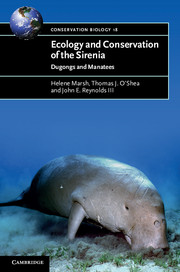Book contents
- Frontmatter
- Contents
- Foreword
- Preface
- Acknowledgements
- 1 Introduction
- 2 Steller’s sea cow
- 3 Affinities, origins and diversity of the Sirenia through time
- 4 Feeding biology
- 5 Behaviour and habitat use
- 6 Life history, reproductive biology and population dynamics
- 7 Threats
- 8 Conservation status
- 9 Conservation opportunities
- References
- List of online supplementary material
- Index
- Plate section
9 - Conservation opportunities
Published online by Cambridge University Press: 05 January 2012
- Frontmatter
- Contents
- Foreword
- Preface
- Acknowledgements
- 1 Introduction
- 2 Steller’s sea cow
- 3 Affinities, origins and diversity of the Sirenia through time
- 4 Feeding biology
- 5 Behaviour and habitat use
- 6 Life history, reproductive biology and population dynamics
- 7 Threats
- 8 Conservation status
- 9 Conservation opportunities
- References
- List of online supplementary material
- Index
- Plate section
Summary
As discussed in Chapters 3–6, manatees and dugongs are long-lived, slow breeding, aquatic herbivores with a low metabolic rate. This life history means that their populations are sensitive to both mortality, especially adult mortality, and habitat loss. Dugongs and manatees are subject to a range of threats (Chapter 7), the relative importance of which varies with location and particularly whether the range state is a developed or developing country. The capacity of a country to implement effective conservation actions also varies with its developmental stage; in general, developing countries are likely to have a lower capacity to implement effective conservation than developed countries (Leverington et al. 2008; Table 8.9).
Our review of sirenian research (Chapters 3–6) is largely based on Florida manatees and Australian dugongs, because those populations are the ones that have provided the bulk of our knowledge. Ironically, these are among the sirenian populations most likely to persist (Table 8.9). This situation is not a coincidence, as extensive scientific information can inform effective conservation decisions. However, as noted in Chapter 1 and by Reynolds et al. (2009), lack of science is not the primary factor that is preventing the conservation of sirenians and other marine mammals. Indeed, developing tropical nations should not wait for science at the pace and sophistication of the developed world before implementing conservation actions. Rather, the science learned elsewhere in broad outline will be for the most part transferable to conservation of Trichechus senegalensis, T. inunguis, T. m. manatus and most populations of dugongs, as assumed in the sirenian conservation primer by Hines et al. (2012b).
- Type
- Chapter
- Information
- Ecology and Conservation of the SireniaDugongs and Manatees, pp. 397 - 434Publisher: Cambridge University PressPrint publication year: 2011



